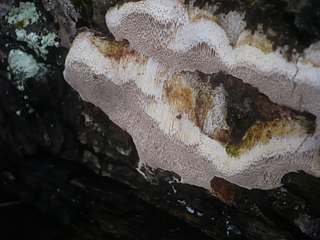
Junghuhnia is a genus of crust fungi in the family Steccherinaceae. It was circumscribed by Czech mycologist August Carl Joseph Corda in 1842. The generic name honours German-Dutch botanist Franz Wilhelm Junghuhn.

The Polyporaceae are a family of poroid fungi belonging to the Basidiomycota. The flesh of their fruit bodies varies from soft to very tough. Most members of this family have their hymenium in vertical pores on the underside of the caps, but some of them have gills or gill-like structures. Many species are brackets, but others have a definite stipe – for example, Polyporus badius.

Perenniporia is a cosmopolitan genus of bracket-forming or crust-like polypores in the family Polyporaceae. They are dimitic or trimitic with smooth, thick-walled basidiospores and cause a white rot in affected wood.

Postia is a genus of brown rot fungi in the family Fomitopsidaceae.

Phylloporia is a genus of polypore fungi in the family Hymenochaetaceae. A 2012 estimate placed 23 species in the genus; this number was increased to 30 by 2015.
Leif Randulff Ryvarden is a Norwegian mycologist.

Ceriporia is a widely distributed genus of crust fungi.
Australicium is a genus of corticioid fungi in the family Phanerochaetaceae. The genus was circumscribed by mycologists Kurt Hjortstam and Leif Ryvarden in 2002 to contain the type species, A. singulare, which is found in New Zealand. The Venezuelan species A. cylindrosporum was added to the genus in 2005.

Antrodiella is a genus of fungi in the family Steccherinaceae of the order Polyporales.

Amauroderma is a genus of polypore fungi in the family Ganodermataceae. The genus, widespread in tropical areas, contains about 70 species. Amauroderma fungi are wood-decay fungi that feed and fruit on decayed branches and trunks.

Dichomitus is a genus of poroid crust fungi in the family Polyporaceae. It was circumscribed by English mycologist Derek Reid in 1965.

Diplomitoporus is a genus of fungi in the family Polyporaceae. The Dictionary of the Fungi estimated the widespread genus to contain 11 species; since then, the genus has grown with the additional of several newly described species, and some transfers from other genera. Diplomitoporus has been described as a wastebasket taxon, containing "species that share common macroscopic and microscopic characteristics, but are not necessarily related."
Grammothele is a genus of poroid crust fungi in the family Polyporaceae.

Hapalopilus is a genus of poroid fungi in the family Polyporaceae. The genus is widely distributed. The generic name combines the Ancient Greek words ἁπαλός ("tender") and πιλος ("cap"). Hapalopilus was circumscribed by Finnish mycologist Petter Adolf Karsten in 1881.

Spongipellis is a genus of fungi in the family Polyporaceae. The genus is widely distributed and contains ten species. The genus was circumscribed by French mycologist Narcisse Théophile Patouillard in 1887. The genus name combines the Latin words spongia ("sponge") and pellis ("skin").

Skeletocutis is a genus of about 40 species of poroid fungi in the family Polyporaceae. The genus has a cosmopolitan distribution, although most species are found in the Northern Hemisphere. It causes a white rot in a diverse array of woody substrates, and the fruit bodies grow as a crust on the surface of the decaying wood. Sometimes the edges of the crust are turned outward to form rudimentary bracket-like caps.

Tyromyces is a genus of poroid fungi in the family Polyporaceae. It was circumscribed by mycologist Petter Karsten in 1881. The type species is the widely distributed Tyromyces chioneus, commonly known as the white cheese polypore. The phylogenetic position of Tyromyces within the Polyporales is uncertain, but it appears that it does not belong to the "core polyporoid clade". Tyromyces is polyphyletic as it is currently circumscribed, and has been described as "a dumping place for monomitic white-rot species with thin-walled spores."
Junghuhnia africana is a species of crust fungus in the family Steccherinaceae. The type specimen was collected in Bwindi Impenetrable National Park, Uganda, growing on a rotting hardwood log. Its ellipsoid spores measure 5–6 by 4–4.5 µm. The fungus was described as new to science in 2005 by mycologists Perpetua Ipulet & Leif Ryvarden.
Junghuhnia glabricystidia is a species of crust fungus in the family Steccherinaceae. The type specimen was collected in Kibale National Park, western Uganda, growing on a rotting hardwood log. The crust-like fruit bodies of the fungus measure up to 1 cm wide, 3 cm long, and 3 mm thick. The pore surface is white to cream, with round pores numbering 4 to 5 per millimetre. The tube layer, which is the same colour as the pore surface, is up to 2 mm deep, with a 1-mm thick subiculum. Its ellipsoid spores measure 4–5 by 3–3.5 µm. The fungus was described as new to science in 2005 by mycologists Perpetua Ipulet & Leif Ryvarden.
Trametes africana is a poroid bracket fungus in the family Polyporaceae. It was described as new to science in 2004 by Norwegian mycologist Leif Ryvarden. It is found in Africa, where it has been recorded from Cameroon, Ethiopia, Kenya, Rwanda and Uganda. The fungus is characterized by its perennial habit and hard woody fruit bodies that become reddish to bay in colour with a waxy surface texture around the base. The pore surface and context are brownish to yellowish. Spores made by the fungus are cylindrical, hyaline, and thin-walled, measuring 5–8 by 2.5–3.3 µm.













